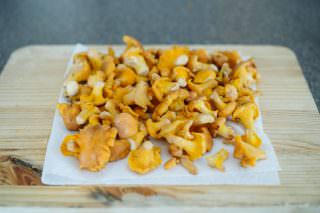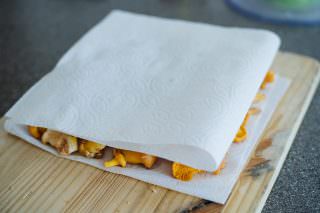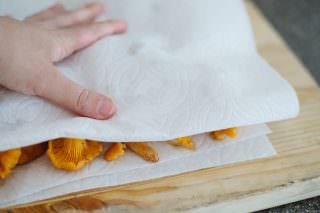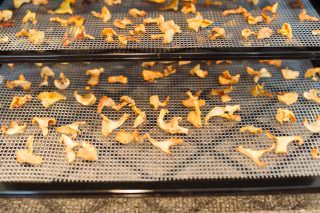If you found your way into this blog entry, the chances are you are here to learn more about how to dehydrate chanterelles. I have used multiple ways to dehydrate mushrooms. The best way, time and time again is to use a dehydrator to have that perfectly dry and dehydrated muhsrooms.
For this tutorial I am going to be using chanterelles. We picked quite a bit of chanterelles this year and whatever we couldn’t eat either went into sautes or I wet froze them to have it ready for winter use. The last batch I have is being used for dehydration purposes.
Dehydrated chanterelles are a heavenly sight. You can incorporate them in soups, stews and whole bunch of other things. The process of dehydrating chanterelle mushrooms is very, very easy! As long as you have a dehydrator, you are set. Well, you will also need them chanterelles, lol. Let’s get down to learning about how to dehydrate chanterelles, shall we?
Ingredients and tools:
- Chanterelles
- Dehydrator Machine
Directions:
There are important steps to keep in mind if you want the dehydration process for chanterelles (or any other mushrooms for that matter) to go smoothly. There is no need to deep wash or soak mushrooms in water in order to clean them. Remember that mushrooms are essentially like porous sponges. They’ll soak up a lot of water. Since we are trying to get rid of the the excess water, soaking the chanterelles in water might be a little counter productive. Just cleaning them off under a running water, or using a small brush to clean off the dirt should suffice. When you will get to cooking the dry mushrooms later, you can always further wash it off. If you absolutely must wash the mushrooms, make sure you thoroughly dry them with paper towels.
Slice mushrooms lengthwise at about 1/4 inch thickness. Smaller mushrooms can be kept without being cut. If they are small enough, their size will be sufficient enough to be dried wholly.
Employ your children or anyone idly zooming around to help you with stacking the chanterelles on the dehydrator nets. In this case my son had nothing better to do. So, I asked him to help me with the process of lining the mushrooms on the dehydrator nets/trays.
Place the nets inside the dehydrator machine and set the temperature accordingly. Here where it gets a little geeky. There are a lot of views out there regarding the temperature settings for dehydrating mushrooms. Some claim that the lower the setting the better your results. That’s of course when it comes to preserving most of the nutritious value of the mushrooms. Some say even if you go higher with the temperature, the nutritional value of the mushrooms will not suffer badly.
I have read that some people “nuke” their mushrooms close to 160F. Some go as low as 105F. The difference, aside from the nutritional value, is obviously the time you are going to end up using the dehydrator. I like to keep it at the middle ground, with 125F. I also recommend you check the dehydrator every 2 hours. It also depends on how well your dehydrator works. Excalibur works like a charm. So, I only used it for about 4 hours at 125F. Some people end up using their dehydrator overnight. That I haven’t done yet. Either way, please read the manual that comes with your dehydrator. Do a little research, use my tutorial and you’ll be set.
Like I mentioned above, check the dehydrator every couple of hours or so to see if the process is going well. You’ll know the mushrooms are dehydrated enough when the texture becomes leathery and the mushrooms snap like a cracker when bent. I let the mushrooms cool a bit and place them in an airtight container or a space saver bag for storage. Dehydrated chanterelles will store well in air-tight container. The shelf life of these can span for multiple years. That’s of course if you’ll not finish them within a couple of months.
I hope you found this tutorial about how to dehydrate chanterelles useful. If you have any questions, do leave them in the comment section. I’ll be glad to respond do your questions or concerns.
How To Dehydrate Chanterelles
Ingredients
- Chanterelles
- Dehydrator Machine
Instructions
- There are important steps to keep in mind if you want the dehydration process for chanterelles (or any other mushrooms for that matter) to go smoothly. There is no need to deep wash or soak mushrooms in water in order to clean them. Remember that mushrooms are essentially like porous sponges. They’ll soak up a lot of water. Since we are trying to get rid of the the excess water, soaking the chanterelles in water might be a little counter productive. Just cleaning them off under a running water, or using a small brush to clean off the dirt should suffice. When you will get to cooking the dry mushrooms later, you can always further wash it off. If you absolutely must wash the mushrooms, make sure you thoroughly dry them with paper towels.
- Slice mushrooms lengthwise at about 1/4 inch thickness. Smaller mushrooms can be kept without being cut. If they are small enough, their size will be sufficient enough to be dried wholly.
- Employ your children or anyone idly zooming around to help you with stacking the chanterelles on the dehydrator nets. In this case my son had nothing better to do. So, I asked him to help me with the process of lining the mushrooms on the dehydrator nets/trays.
- Place the nets inside the dehydrator machine and set the temperature accordingly. I set mine to 125F for 4 hours. Check every 2 hours to see the condition of the chanterelles. If not ready, set for another 2 hours.
- You’ll know the mushrooms are dehydrated enough when the texture becomes leathery and the mushrooms snap like a cracker when bent. I let the mushrooms cool a bit and place them in an airtight container or a space saver bag for storage. Dehydrated chanterelles will store well in air-tight container.













I have read in other blogs about drying chanterelles that they become very “rubbery” after drying and that you can’t soak them long enough to overcome this. Do you have any comment regarding this? I found a bunch of these mushrooms yesterday and will never be able to eat them all. I dearly want to preserve some of them for future use. Thanks for your comments.
Hi Bill, I personally don’t have a problem with using dehydrated chanties. Maybe because I love using it in soups and mostly use my pressure cooker to soften them up. Why don’t you freeze them if you are a little worried about dehydrating chanterelles? Freezing works like a charm every time. Wash, dry, place in ziplocks or space savers suck the air out and freeze. When you are ready to use them, just dump the mushrooms out on the skillet, without defrosting and get on cooking. Comes out delicious every time!
Here is another idea for you. You can pre-cook and preserve chanterelles. I wish I had done more of these last season. They seem to be gone first. https://arbuz.com/recipes/how-to-preserve-chanterelles/
I always flash dry in a hot pan until they release some of their water- strain liquid into a pot (super yummy mushroom broth!) then freeze flat on a cookie sheet. Once frozen I pop them into freezer bags. It’s a little extra work but well worth the effort. Tonight I am trying dehydrating. I have some washed and sliced and others that I flash fried. I’ll let you know which I prefer.
Awesome, Arleigh. I so envy you! Our mushroom season was a huge miss this year. It was a very dry season in Colorado. Dehydrated ones are amazing if used in soups. The flavor just oozes from the soups or the strews. I love making beef and barley soup, especially in the slow cooker or a pressure cooker. Dehydrated mushrooms usually take a little longer to cook. Let me know how things are turning out.
We pick loads in Canada and want to bring them back to the US. Two years ago we dehydrated them, put them in bags, but as soon as we hit the northeast humity they became moldy. Last year after dehydrateing them we vacuum sealed them. This worked well but when we opened them in December they literrally turned to dust, they were not crushed in transit, the were still whole in the bag. So instead of rehydrated whole mushrooms we had mushroom powder. How do we prevent that?
Here’s another tip that has worked well for me in Western Oregon. Seal your dried mushrooms in a jar with cornmeal. The cornmeal absorbs any residual moisture, either from inside the mushrooms themselves or dampness from the the environment as you open the jar to use mushrooms a few at a time. The cornmeal also absorbs some of the mushroom aroma and flavor, which is delicious used in gravies, stews, soups and polenta.
We are all getting those little silica gel packets that we can reuse. You can even restore their ability by dehydrating them with your mushrooms. Cornmeal sounds good too.
I’ve been picking mushrooms mostly Central most of my life never had a problem with freeze drying about 10 years ago I began dehydrating once they were dehydrated we would put them into large cars and and then give the jars away as Christmas presents to friends and family never had a problem with them dehydrated mushroom molding unless it wasn’t dehydrated well enough